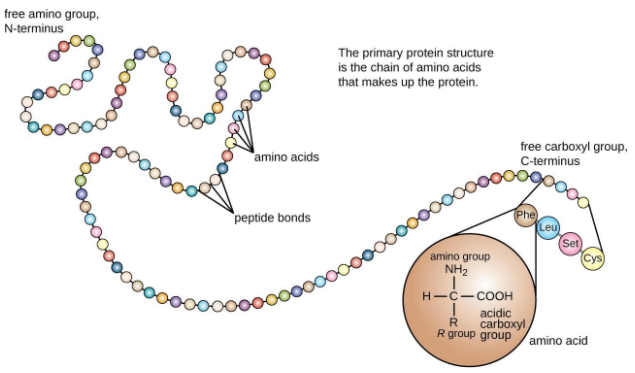
Write a short note on C-terminal group analysis for amino acids.
Answer
468.9k+ views
Hint: All proteins are macromolecules because they have very high molecular weights. Chain-like molecules produced by joining a number of small units of amino acids called monomers i.e. these are polymers. The amino acids are, therefore, regarded as ‘building blocks of proteins’.
Complete answer:
The amino acid units are linked together through the carboxyl and amino groups to produce the primary structure of the protein chain. The bond between two adjacent amino acids is a special type of amide bond, known as peptide bond and the chain is called peptide chain.
Each amino acid in the chain is termed as residue. The two ends of the peptide chain are named as an N-terminal and C-terminal or simply as amino terminal and carboxyl terminal respectively. These two terminal groups, one basic and another acidic, are the only ionizable groups of any peptide chain except those present in the side chain.
The terminal amino acid with the free amino group is called as N-terminal and the one with the free carboxyl group at the other end as C-terminal amino acid. The C-terminal residue forms its fangs and is written in the end during the naming of polypeptide while the N-terminal residue forms its rattle and is written in the first.

Note: Each peptide chain is of considerable length and may possess from 50 to millions of amino acids units. Depending on the number of amino acid molecules composing a chain, the peptides may be termed as a dipeptide, a tripeptide and so on. If a peptide is made up of less and equal to the 10 amino acids, then it is called an oligopeptide.
Complete answer:
The amino acid units are linked together through the carboxyl and amino groups to produce the primary structure of the protein chain. The bond between two adjacent amino acids is a special type of amide bond, known as peptide bond and the chain is called peptide chain.
Each amino acid in the chain is termed as residue. The two ends of the peptide chain are named as an N-terminal and C-terminal or simply as amino terminal and carboxyl terminal respectively. These two terminal groups, one basic and another acidic, are the only ionizable groups of any peptide chain except those present in the side chain.
The terminal amino acid with the free amino group is called as N-terminal and the one with the free carboxyl group at the other end as C-terminal amino acid. The C-terminal residue forms its fangs and is written in the end during the naming of polypeptide while the N-terminal residue forms its rattle and is written in the first.

Note: Each peptide chain is of considerable length and may possess from 50 to millions of amino acids units. Depending on the number of amino acid molecules composing a chain, the peptides may be termed as a dipeptide, a tripeptide and so on. If a peptide is made up of less and equal to the 10 amino acids, then it is called an oligopeptide.
Recently Updated Pages
Master Class 11 Business Studies: Engaging Questions & Answers for Success

Master Class 11 English: Engaging Questions & Answers for Success

Master Class 11 Computer Science: Engaging Questions & Answers for Success

Master Class 11 Social Science: Engaging Questions & Answers for Success

Master Class 11 Maths: Engaging Questions & Answers for Success

Master Class 11 Biology: Engaging Questions & Answers for Success

Trending doubts
Differentiate between an exothermic and an endothermic class 11 chemistry CBSE

One Metric ton is equal to kg A 10000 B 1000 C 100 class 11 physics CBSE

Explain zero factorial class 11 maths CBSE

State the laws of reflection of light

What is 1s 2s 2p 3s 3p class 11 chemistry CBSE

Difference Between Prokaryotic Cells and Eukaryotic Cells




